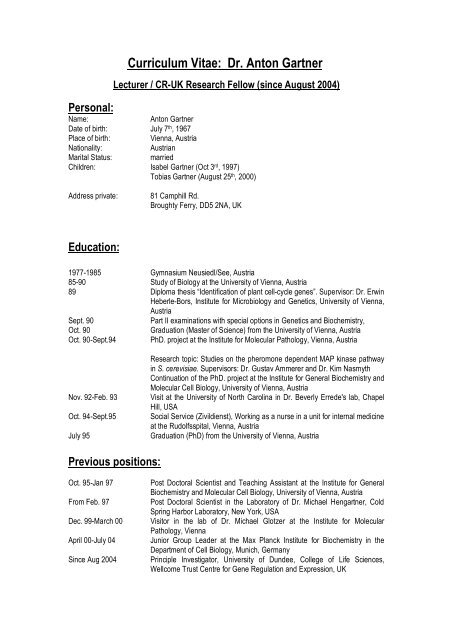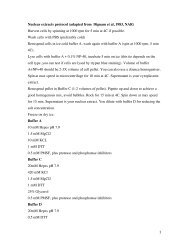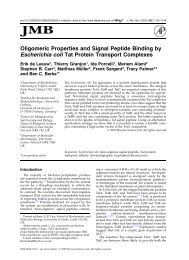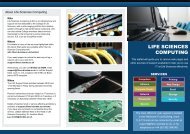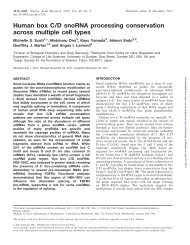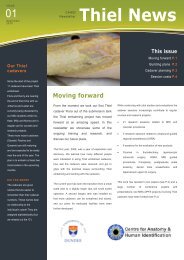Curriculum Vitae: Dr. Anton Gartner - College of Life Sciences ...
Curriculum Vitae: Dr. Anton Gartner - College of Life Sciences ...
Curriculum Vitae: Dr. Anton Gartner - College of Life Sciences ...
Create successful ePaper yourself
Turn your PDF publications into a flip-book with our unique Google optimized e-Paper software.
<strong>Curriculum</strong> <strong>Vitae</strong>: <strong>Dr</strong>. <strong>Anton</strong> <strong>Gartner</strong><br />
Lecturer / CR-UK Research Fellow (since August 2004)<br />
Personal:<br />
Name: <strong>Anton</strong> <strong>Gartner</strong><br />
Date <strong>of</strong> birth: July 7 th , 1967<br />
Place <strong>of</strong> birth: Vienna, Austria<br />
Nationality: Austrian<br />
Marital Status: married<br />
Children: Isabel <strong>Gartner</strong> (Oct 3 rd , 1997)<br />
Tobias <strong>Gartner</strong> (August 25 th , 2000)<br />
Address private: 81 Camphill Rd.<br />
Broughty Ferry, DD5 2NA, UK<br />
Education:<br />
1977-1985 Gymnasium Neusiedl/See, Austria<br />
85-90 Study <strong>of</strong> Biology at the University <strong>of</strong> Vienna, Austria<br />
89 Diploma thesis “Identification <strong>of</strong> plant cell-cycle genes”. Supervisor: <strong>Dr</strong>. Erwin<br />
Heberle-Bors, Institute for Microbiology and Genetics, University <strong>of</strong> Vienna,<br />
Austria<br />
Sept. 90 Part II examinations with special options in Genetics and Biochemistry,<br />
Oct. 90 Graduation (Master <strong>of</strong> Science) from the University <strong>of</strong> Vienna, Austria<br />
Oct. 90-Sept.94 PhD. project at the Institute for Molecular Pathology, Vienna, Austria<br />
Research topic: Studies on the pheromone dependent MAP kinase pathway<br />
in S. cerevisiae. Supervisors: <strong>Dr</strong>. Gustav Ammerer and <strong>Dr</strong>. Kim Nasmyth<br />
Continuation <strong>of</strong> the PhD. project at the Institute for General Biochemistry and<br />
Molecular Cell Biology, University <strong>of</strong> Vienna, Austria<br />
Nov. 92-Feb. 93 Visit at the University <strong>of</strong> North Carolina in <strong>Dr</strong>. Beverly Errede's lab, Chapel<br />
Hill, USA<br />
Oct. 94-Sept.95 Social Service (Zivildienst), Working as a nurse in a unit for internal medicine<br />
at the Rudolfsspital, Vienna, Austria<br />
July 95 Graduation (PhD) from the University <strong>of</strong> Vienna, Austria<br />
Previous positions:<br />
Oct. 95-Jan 97 Post Doctoral Scientist and Teaching Assistant at the Institute for General<br />
Biochemistry and Molecular Cell Biology, University <strong>of</strong> Vienna, Austria<br />
From Feb. 97 Post Doctoral Scientist in the Laboratory <strong>of</strong> <strong>Dr</strong>. Michael Hengartner, Cold<br />
Spring Harbor Laboratory, New York, USA<br />
Dec. 99-March 00 Visitor in the lab <strong>of</strong> <strong>Dr</strong>. Michael Glotzer at the Institute for Molecular<br />
Pathology, Vienna<br />
April 00-July 04 Junior Group Leader at the Max Planck Institute for Biochemistry in the<br />
Department <strong>of</strong> Cell Biology, Munich, Germany<br />
Since Aug 2004 Principle Investigator, University <strong>of</strong> Dundee, <strong>College</strong> <strong>of</strong> <strong>Life</strong> <strong>Sciences</strong>,<br />
Wellcome Trust Centre for Gene Regulation and Expression, UK
Original scientific publications<br />
Master Thesis, PhD and Postdoctoral Work<br />
1) J. Györgey, A. <strong>Gartner</strong>, K. Nemeth, Z. Magyar, H. Hirt, E. Heberle-Bors and D. Dudits. (1991). Alfalfa<br />
heat shock genes are differentially expressed during somatic embryogenesis. Plant Mol. Biol. 16, 999-<br />
1007.<br />
2 ) H. Hirt, M. Mink, M. Pfosser, L. Börge, J. Györgey, C. Jonak, A. <strong>Gartner</strong>, D. Dudits and E. Heberle<br />
Bors. (1992). Alfalfa Cyclins: Differential Expression during the Cell cycle and in Plant Organs. The<br />
Plant Cell, 4, 1531-1538.<br />
3) H. Hirt, A. <strong>Gartner</strong>, E. Heberle-Bors. (1992). An Alfalfa cDNA encodes a protein with similarity to<br />
human snRNP-E. Nuc. Acid. Res., 20, 613.<br />
4) A. <strong>Gartner</strong>, K. Nasmyth and G. Ammerer. (1992). Signal transduction in S. cerevisiae requires<br />
threonine and tyrosine phosphorylation <strong>of</strong> Fus3 and Kss1. Genes and Development, 6, 1305-1318.<br />
5) B. Errede, A. <strong>Gartner</strong>, Zhaoqing Zhou, K. Nasmyth and G. Ammerer. (1993). A pheromone induced<br />
kinase cascade in S. cerevisiae: activation <strong>of</strong> the Fus3 kinase by the Ste7 kinase in vitro. Nature, 362,<br />
261-264.<br />
6) Zhaoqing Zhou, A. <strong>Gartner</strong>, R. Cade G. Ammerer and B. Errede. (1993). Pheromone induced signal<br />
transduction in S. cerevisiae requires the sequential function <strong>of</strong> three protein kinases. Mol. Cell Biol.,<br />
13, 2069-2080.<br />
7) M. Peter, A. <strong>Gartner</strong>, J. Horecka, G. Ammerer and I. Herskowitz. (1993). Far1 links the signal<br />
transduction pathway to the cell cycle machinery in yeast. Cell, 73, 747-760.<br />
8) C. Wilson, N. Eller, A. <strong>Gartner</strong>, O. Vincente, E. Heberle-Bors. (1994). Isolation and characterization<br />
<strong>of</strong> a tobacco cDNA clone encoding a putative MAP kinase. Plant Mol. Biol., 23, 543-551.<br />
9) C. Doi, A. <strong>Gartner</strong>, G. Ammerer, H. Shinkawa, B. Errede, K. Suigimoto and K. Matsumoto. (1994). A<br />
protein phosphatase promotes adaptation to pheromone response in S. cerevisiae. EMBO J., 13, 61-70.<br />
10) A. <strong>Gartner</strong>*, A. Jovanovic, D-I. Jeoung, S. Bourlat, F. Cross and G. Ammerer. (1998). Pheromone<br />
dependent G1 cell cycle arrest requires Far1 phosphorylation, but may not involve inhibition <strong>of</strong> the<br />
Cdc28/Cln2 kinase, in vivo. Mol. Cell Biol., 18, 3681-3691.<br />
*Corresponding author<br />
11) A. <strong>Gartner</strong>, S. Milstein, S. Ahmed J. Hodgkin and M. Hengartner. (2000). A conserved checkpoint<br />
pathway mediates DNA damage-induced apoptosis and cell cycle arrest in C. elegans. Mol. Cell, 5,<br />
435-444.<br />
Publications as independent group leader<br />
12) S. Ahmed, A. Alpi, M. Hengartner and A. <strong>Gartner</strong>. (2001). C. elegans RAD-5/CLK-2 defines a new<br />
DNA damage checkpoint protein. Current Biology, Dec 11, 11(24): 1-20.<br />
13) B. Schumacher, K. H<strong>of</strong>mann, S. Boulton and A. <strong>Gartner</strong>. (2001). The C. elegans homolog <strong>of</strong> the<br />
p53 tumor suppressor is required for DNA damage induced apoptosis. Current Biology, Oct 30;<br />
11(21): 1722-7.
14) SJ. Boulton, A. <strong>Gartner</strong>, J. Reboul, P. Vaglio, N. Dyson, DE. Hill, M. Vidal. (2002). Combined<br />
Functional Genomic Maps <strong>of</strong> the C. elegans DNA Damage Response. Science, Jan 4, 127-131.<br />
15) U. Grueneberg, M. Glotzer, A. <strong>Gartner</strong>, EA. Nigg. (2002). The CeCDC-14 phosphatase is required<br />
for cytokinesis in the Caenorhabditis elegans embryo. J. Cell Biol.,158(5): 901-14.<br />
16) R. H<strong>of</strong>mann, S. Milstein, S. Boulton, J. Ye, J. H<strong>of</strong>mann, L. Stergiou, A. <strong>Gartner</strong>, M. Vidal , and M.<br />
Hengartner. (2002). Caenorhabditis elegans HUS-1 is a DNA damage checkpoint protein required for<br />
genome stability and EGL-1-mediated apoptosis. Current Biology, 12(22): 1908-18.<br />
17) A. Alpi, P. Pasierbek, A <strong>Gartner</strong>, J. Loidl. (2003). Genetic and cytological characterization <strong>of</strong> the<br />
recombination protein RAD-51 in Caenorhabditis elegans. Chromosoma, 112(1): 6-16<br />
18) SJ. Boulton, JS. Martin, J. Polanowska, DE. Hill, A. <strong>Gartner</strong> and M. Vidal. (2004). BRCA1/BARD1<br />
orthologues required for DNA repair in Caenorhabditis elegans, Current Biology. 14(1): 33-9.<br />
19) C. Wicky, A. Alpi, A. Rose, A. <strong>Gartner</strong>* and F. Müller. (2004). Multiple genetic pathways involving<br />
C. elegans him-6/Blooms, mre-11, rad-51 and top-3 are needed to maintain genome stability in germ<br />
line, Mol. Cell Biol. 24(11): 5016-27.<br />
*Co-corresponding author<br />
20) B. Schumacher, C. Schertel, N.Wittenburg, S. Tuck, S. Mitani, A. <strong>Gartner</strong>*, B. Conradt and SC.<br />
Shaham. (2005). C. elegans ced-13 can promote apoptosis and is induced in response to DNA<br />
damage.<br />
Cell Death Differ., 12(2): 153-61<br />
*Co-corresponding author<br />
21) B. Schumacher, M. Hanazawa, MH. Lee, S. Nayak, K. Volkmann; R. H<strong>of</strong>mann, M. Hengartner, T.<br />
Schedl and A. <strong>Gartner</strong> (2005).Translational Repression <strong>of</strong> C. elegans p53 by GLD-1 regulates DNA<br />
damage induced apoptosis. Cell 120: 357-368<br />
22) B. Meier, I. Clejab, Y. Liu, M. Lowden, A. <strong>Gartner</strong>, J. Hodgkin and S. Ahmed (2006). trt-1 Is the<br />
Caenorhabditis elegans Catalytic Subunit <strong>of</strong> Telomerase. PLoS Genetics, Feb 10; 2(2)<br />
23) A. Woodward , T. Göhler , M. Gloria Luciani, , M. Oehlmann, X. Ge, A. <strong>Gartner</strong>, D. Jackson and J.<br />
Blow (2006) Excess Mcm2-7 license dormant origins <strong>of</strong> replication for use when replication fork<br />
progress is inhibited, J. Cell Biol., Jun 5; 173(5): 673-83<br />
24) V. Jantsch, L. Tang, P. Pasierbek, A. Penkner, S. Nayak, A. Baudrimont, T. Schedl, A. <strong>Gartner</strong>, J.<br />
Loidl (2007). Caenorhabditis elegans prom-1 is required for meiotic prophase progression and<br />
homologous chromosome pairing. Mol Biol Cell, Dec; 18(12): 4911-20.<br />
25) H. Lee, LJ. Cho, N. Lambacher, J. Lee, SJ. Lee, TH. Lee, A. <strong>Gartner</strong>, HS. Koo. (2008). The C.<br />
elegans AMP-activated protein kinase AAK-2 is phosphorylated by LKB1 and required for resistance to<br />
oxidative stress and for normal motility and foraging behavior. J. Biol. Chem., Apr 11;<br />
26) S. Greiss, B. Schumacher, K. Grandien, J. Rothblatt, A. <strong>Gartner</strong>. (2008). Transcriptional pr<strong>of</strong>iling in<br />
C. elegans suggests DNA damage dependent apoptosis as an ancient function <strong>of</strong> the p53 family. BMC<br />
Genomics. Jul 15; 9: 334.<br />
27) J. Mouysset, A. Deichsel, S. Moser C. Hoege, A. Hyman, A. <strong>Gartner</strong>, T. Hoppe. (2008). Cell cycle<br />
progression requires the CDC-48UFD-1/NPL-4 complex for efficient DNA replication. Proc Natl Acad<br />
Sci, USA, Sep, 105(35): 12879-84.
28) S. Greiss, J. Hall, S. Ahmed, A. <strong>Gartner</strong>. C. elegans SIR-2.1 translocation is linked to a proapoptotic<br />
pathway parallel to cep-1/p53-like during DNA damage induced apoptosis (2008) Genes &<br />
Development, Oct, 22(20): 2831-41.<br />
29) S. Moser, S. von Elsner, I. Buessing, A. Alpi, R. Schnabel, A. <strong>Gartner</strong>. (2009). Functional<br />
Dissection <strong>of</strong> C. elegans CLK2/TEL2 cell cycle defects during embryogenesis and germ line<br />
development, PLOS Genetics, in press<br />
Papers under revision<br />
30) B. Meier, L. Barber, Y. Liu Y, I, Clejan, S. Boulton, A. <strong>Gartner</strong>*, S. Ahmed.* (2009), The MRT-1<br />
nuclease is required for DNA cross link repair and telomerease activity in vivo in C. elegans, under<br />
revision EMBO J.,<br />
*equal senior author contribution with S. Ahmed<br />
31) SJ. Lee, A. <strong>Gartner</strong>, M. Hyun, B. Ahn, and HS. Koo. (2009), A Werner syndrome protein in C.<br />
elegans functions upstream <strong>of</strong> ATR and ATM in response to DNA replication inhibition and doublestrand<br />
DNA breaks, under revision Mol. Cell Biol.,<br />
Papers under review<br />
32) A. Bailly, AC. Déclais, J. Hall, A. Freeman, A. Alpi, D. Lilley, S. Ahmed and A. <strong>Gartner</strong>. (2009). The<br />
C. elegans Gen-1 Holliday Junction Resolvase like enzyme links DNA double strand break repair and<br />
DNA damage signalling, submitted.<br />
Scientific reviews and bookchapters<br />
PhD and Postdoctoral Work<br />
33) A. <strong>Gartner</strong>. (1994). The role <strong>of</strong> protein phosphatases in the adaptation to the pheromone response<br />
in yeast. In Advances in Protein Phosphatases; Leuven University Press 1994, 153-162.<br />
34) A. <strong>Gartner</strong> and M. Hengartner. (1997). Genetic approaches to programmed cell death in C.<br />
elegans. In ‘When Cells Die’; John Wiley and Sons, Publications 1997, 131-146.<br />
Publications published as independent group leader<br />
35) A. <strong>Gartner</strong>, A. Alpi and B. Schumacher. (2003). Programmed Cell Death in C. elegans, Stefan<br />
Grimm ed. Bios<br />
36) B. Schumacher, A. Alpi and A. <strong>Gartner</strong>. (2003). Cell cycle: Check for asynchrony, Current Biology,<br />
R560-R562.<br />
37) A. <strong>Gartner</strong>. (2003). Genome-wide genetic screening by RNAi - a glimpse <strong>of</strong> the future, The ELSO<br />
Gazette, Vol 14, April<br />
38) A. <strong>Gartner</strong>, AJ. MacQueen and AM. Villeneuve. (2004). Methods for analyzing checkpoint<br />
responses in Caenorhabditis elegans, Methods in Molecular Biology, entitled "Checkpoint Controls and<br />
Cancer". Methods Mol. Biol., 280: 257-74.<br />
39) AM. Leroi, A. Bartke, G. De Benedictis, C. Franceschi, A. <strong>Gartner</strong>, E. Gonos, ME. Feder, T. Kivisild,<br />
S. Lee, N. Kartal-Ozer, M. Schumacher, E. Sikora, E. Slagboom, M. Tatar, Al Yashin, J Vijg, B. Zwaan<br />
(2005). What evidence is there for the existence <strong>of</strong> individual genes with antagonistic pleiotropic effects.<br />
Mech. Ageing Dev., 126(3): 421-9.
40) B. Schumacher and A. <strong>Gartner</strong>. (2006). Translational regulation <strong>of</strong> p53 as a potential tumor therapy<br />
target Future Oncol., 2(1), 145-153<br />
41) B. Meier and A. <strong>Gartner</strong>. (2006). Meiosis: Checking Chromosomes Pair up Properly. Current<br />
Biology, R249-R251<br />
42) A. <strong>Gartner</strong>, PR. Boag and TK. Blackwell (2008). Germline Survival and Apoptosis, WormBook, ed.<br />
The C. elegans Research Community, WormBook, Sept; 1-20<br />
Submitted scientific reviews and bookchapters<br />
43) A. Bilitou, J. Watson, A. <strong>Gartner</strong> and S.Ohnuma. (2009). The NM23 family in development.<br />
Invited scientific reviews and bookchapters<br />
44) K. H<strong>of</strong>mann, R. Rutkowski, A. <strong>Gartner</strong>. (2009). p53 Functions in Invertebrates, Evolutionary<br />
Origins, Cold Spring Harbor press.<br />
Patent Applications<br />
M. Hengartner, A. <strong>Gartner</strong> and S. Milstein. (1998). Damage induced apoptosis. US patent application<br />
No. 60/090,507<br />
Fellowships awarded<br />
Max Kade fellowship (Feb 1997, declined), Austria, USA<br />
EMBO long term fellowship (June 1997), Europe<br />
Schroedinger fellowship (April 1999), Austria<br />
CR-UK Career Development Award (December 2003), UK<br />
Grants<br />
Far1 regulation in pheromone dependent cell cycle arrest in S. cerevisiae (Jubiläumsfonds der<br />
österreichischen Nationalbank 1996), Austria<br />
Genetic and Molecular Analysis <strong>of</strong> DNA Damage induced Apoptosis and Cell Cycle Arrest in C. elegans<br />
(Deutsche Forschungsgemeinschaft 2000), Germany<br />
Analysis <strong>of</strong> meiotic, apoptosis-inducing checkpoint pathways by genomics-based, forward genetic and two<br />
hybrid approaches in C. elegans (Deutsche Forschungsgemeinschaft 2001), Germany<br />
Genetic and Molecular Analysis <strong>of</strong> DNA Damage induced Apoptosis and Cell Cycle Arrest in C. elegans<br />
(Deutsche Forschungsgemeinschaft 2003), Germany<br />
C11852/A4500 CR-UK Career Development Award Elucidation <strong>of</strong> DNA damage checkpoint pathways<br />
by C. elegans genetics CR-UK Career Development Award 2003). £955,885 (August 2004 - August<br />
2010), UK<br />
C11852/A5991 CR-UK Project Grant (May 2005), Elucidation <strong>of</strong> Novel Negative Regulators <strong>of</strong> DNA Damage<br />
Induced Apoptosis Using C. elegans Genetics. £130,802 (Jan. 2006 - Jan. 2009), UK
Association for International Cancer Research (Nov. 2005), Combined biochemical and genetic approach to<br />
elucidate sir-2 histone deacetylase function in C. elegans DNA damage induced apoptosis. £81,030 (Oct.<br />
2006 -Oct. 2009), UK.<br />
Parkinson Disease Society (March 2006), “Elucidation <strong>of</strong> PINK-1 and LRRk2 function in Parkinson disease<br />
by a combined genetic and biochemical approach in the C. elegans model system” £151,091 (Oct. 2006 -<br />
Oct. 2009) (shared with Dario Alessi), UK<br />
Wellcome Trust (April 2008 - April 2011), Combined genetic and biochemical C. elegans based approach to<br />
understand differential substrate recognition and the mode <strong>of</strong> translational repression <strong>of</strong> the conserved<br />
STAR mRNA binding protein GLD-1 £331,185, UK<br />
COST EU travelling grant (shared with ~25 labs in Europe, from 2008) ca £350,000, EU<br />
C11852/A8052 4 years CR-UK Studentship (Starting from August 2007) ca £120,000, UK<br />
H-0709 Parkinson’s Disease Society 3 years studentship (August 2008 - August 2011), £85,000, UK<br />
Reviewing<br />
I reviewed manuscripts for<br />
Aging Cell, Cell, Cell Death and Differentiation, Current Biology, Development, EMBO J., Experimental<br />
Gerontology, FEBS letters, Genes and Development, Genetics, Journal <strong>of</strong> Cell Science, MCB, Nature Cell<br />
Biology, Nature Review Cell Biology, Oncogene, Plos Genetics and Science. I also reviewed grants for CR-<br />
UK, the BBSRC, the MRC, the Wellcome Trust, the Parkinson Disease Society, for the German DFG and the<br />
Boehringer Ingelheim Fonds, and for the Swiss National Fonds. Currently I review 10 to 15 papers and grant<br />
application per year. In addition, I review ~ 10 grants/ year for the Helsinki panel (see below).<br />
Service in review panels<br />
German DFG study section, Bonn, 2005 Germany<br />
German Landesstiftung Baden Wuertemberg, Stuttgart 2005 Germany<br />
EU COST review panel, Brussels, May 2008, EU<br />
Finnish Academy <strong>of</strong> <strong>Sciences</strong>, Biomedicine I, review panel June 2008), Helsinki, Finland<br />
Finnish Academy <strong>of</strong> <strong>Sciences</strong>, Biomedicine I, review panel June 2009), Helsinki, Finland<br />
Service as PhD examiner<br />
University <strong>of</strong> Dundee Kathryn L. Ball lab, 2006<br />
Frances Fuller Pace lab, 2007<br />
Jean-Christophe Bourdon lab, 2008<br />
Julian Blow lab, 2008<br />
IFROM Milano, Italy Fabrizio d'Adda di Fagagna lab, Jan 2009<br />
Service on CLS committees and administrative roles<br />
Deputy to Tom Owen Hughes for Wellcome Trust Centre for Gene Regulation and Expression, PhD<br />
program<br />
Service in international committees<br />
I was in the organization committee for the 2004 European Worm Meeting.
Management Committee Member <strong>of</strong> EU Cancer and Control <strong>of</strong> Genomic Integrity (CANGENIN) action<br />
Teaching and Supervising<br />
1997 “Biochemisches Praktikum für Fortgeschrittene” (biochemical course for advanced<br />
students), University <strong>of</strong> Vienna, Department <strong>of</strong> Biochemistry, substituting for Gustav<br />
Ammerer<br />
2000 to 2003 “Vienna Worm Course” (University <strong>of</strong> Vienna, Department <strong>of</strong> Cytology). Annual 2 weeks<br />
practical course and students seminar series on C. elegans<br />
2000 to 2004 Taking care <strong>of</strong> rotation students at the MPI for Biochemistry (“Tübinger Studenten”). On<br />
average I had 4 rotation students per year for 6 to 12 weeks each.<br />
Since 2006 Dundee Cell Biology Course (2 lectures)<br />
Since 2007 Dundee Developmental Genetics (3 lectures, two further lectures are given by my Post<br />
Doc Rachael Rutkowski)<br />
Since 2007 Annual lecture at the ENS Lyon, France<br />
Jan 2009 Three lectures at the Pasteur Institute, Paris, France<br />
Taking on Dundee honours students in 2005, 2007 and 2008<br />
Diploma Students<br />
2003-2004 Katrin Volkman (PhD thesis at GSF, Munich Germany)<br />
2004 Nils Lambacher<br />
6 Month Rotation Students<br />
2006 Magali Billet, Université des <strong>Sciences</strong> et Technologies de Lille<br />
(Novartis Institutes for BioMedical Research, Basel Switzerland from<br />
2007)<br />
2007 Adriana Milicov, Université des <strong>Sciences</strong> et Technologies de Lille<br />
(Novartis Institutes for BioMedical Research, Basel Switzerland from<br />
2008)<br />
PhD students<br />
2000 to 2004 Arno Alpi (Principal Investigator, Scills CLS Dundee, UK, from Sept 2009)<br />
Björn Schumacher (Principal Investigator, University <strong>of</strong> Cologne, Germany,<br />
since Jan. 2009)<br />
2003 to 2008 Sebastian Greiss (funded by CR-UK, AICR and Dundee CLS, Post Doc till June,<br />
2009)<br />
Aymeric Bailly (funded by CR-UK, and Dundee CLS, Post Doc, till May 2009,<br />
Post Doc with Thanos Halazonetis from July 2009, University <strong>of</strong> Geneva)<br />
Sandra Moser funded by CR-UK and Dundee CLS) (Post Doc with Jason<br />
Swedlow, CLS Dundee, since 2008)
Since 2007 Ehsan Pourkarimi (funded by CR-UK)<br />
Alper Akay (funded by a Wellcome Trust project grant)<br />
Since 2008 Neda Masudi (funded by the Parkinson’s Disease Society)<br />
Ana Agostinho (funded by BBSRC studentship to Dundee CLS)<br />
Post Docs<br />
2001-2002 co-advising Ulrike Grueneberg (Principal Investigator and CR-UK Career<br />
Development Award Fellow, University <strong>of</strong> Liverpool, since 2007)<br />
2005 until March 2009 Giulio Mafioletti (funded by CR-UK)<br />
Since 2005 Bettina Meier (funded by CR-UK)<br />
Since 2006 Rachael Rutkowski (funded by CR-UK and WT VIP award))<br />
Remi Sonneville (shared with Julian Blow, funded by AICR and EMBO long term<br />
fellowship)<br />
Pablo Ibanez (funded by the Parkinson’s Disease Society)<br />
Since 2007 Ashley Craig (funded by a Wellcome Trust project grant)<br />
Invited Talks and oral presentation at meetings (since 2000)<br />
Sept. 2001 EMBO cell cycle workshop, Salamanca, Spain<br />
Nov. 2001 University <strong>of</strong> Vienna, Austria<br />
Mar. 2003 University <strong>of</strong> Fribourg, Switzerland<br />
Gordon Institute, Cambridge, UK<br />
May 2003 German Society for Cell Biology, Bonn, Germany<br />
ISREC, Lausanne, Switzerland<br />
University <strong>of</strong> Fribourg, Switzerland<br />
July 2003 Technical University <strong>of</strong> Braunschweig, Germany<br />
Aug. 2003 Genetic Toxicology DNA repair meeting, Oxford, UK<br />
Sept. 2003 ENS Lyon, France<br />
Nov. 2003 University <strong>of</strong> Regensburg, Germany<br />
Dec. 2003 EU meeting Brussels (Aging), EU<br />
University <strong>of</strong> Hamburg, Germany<br />
University if Oslo, Norway<br />
Jan. 2004 University <strong>of</strong> Sheffield, UK<br />
Feb. 2004 Institute for Aging Research, Innsbruck, Austria<br />
Sept. 2004 EMBO workshop, Corsica, France<br />
Nov. 2004 University <strong>of</strong> Zurich, Switzerland<br />
June 2005 University <strong>of</strong> Newcastle, UK<br />
July 2005 Plenary talk at International worm meeting (Los Angeles), USA<br />
Oct. 2005 University <strong>of</strong> Turku, Finland<br />
University if Helsinki, Finland<br />
Nov. 2005 University <strong>of</strong> Milano, Italy<br />
Dec. 2005 University <strong>of</strong> Aberdeen, UK<br />
Jan. 2006 Apoptosis Meeting Obergurgl, Austria<br />
March 2006 European Apoptosis Meeting, Crete, Greece<br />
Dundee/ Toulouse Meeting, Toulouse, France<br />
April 2006 Ninewells Hospital Dundee University, UK<br />
University <strong>of</strong> Montreal, Canada<br />
University <strong>of</strong> Toronto, Canada
Jan. 2007 MRC Edinburgh, UK<br />
Feb. 2007 CR-UK Fellows Meeting, UK<br />
April. 2007 p63 Workshop Rome, Italy<br />
FMI Basel, Switzerland<br />
May 2007 ENS Lyon, France<br />
Nov. 2007 University <strong>of</strong> York, UK<br />
Feb. 2008 Ninewells Hospital, Dundee, UK<br />
MRC unit Sussex, UK<br />
June 2008 ENS Lyon, France<br />
Sloan Kettering, New York, USA<br />
Madison C. elegans topic meeting, USA<br />
Nov. 2008 University <strong>of</strong> Helsinki, Finland<br />
Dec. 2008 CR-UK Fellows Meeting, UK<br />
Jan 2009 IFROM, Milano Italy<br />
Pasteur Institute, Paris, France<br />
Apoptosis Meeting Obergurgl, Austria<br />
March 2009 University <strong>of</strong> Michigan Medical School, Ann Arbor, USA<br />
Harvard Medical School, Boston, USA<br />
University <strong>of</strong> Liverpool, UK<br />
May 2009 ENS Lyon, France<br />
GENICA/CANGENIN Workshop in Athens, Greece<br />
June 2009 Association <strong>of</strong> Radiation Research, Meeting, Glasgow, UK<br />
Talks <strong>of</strong> my group members (since 2005)<br />
May 2006 Sebastian Greiss, European C. elegans Meeting, Hersonissos, Crete, Greece,<br />
Jan. 2007 Bettina Meier, Genome Stability Network meeting, Cambridge, UK<br />
May 2007 Bettina Meier, CSHL, meeting Telomere Biology, Cold Spring Harbor, USA<br />
June 2007 Sebastian Greiss, International C. elegans Meeting, University <strong>of</strong> California at Los Angeles<br />
Rachael Rutkowski, International Cell Death Society Symposium, Nice, France<br />
April 2008 Bettina Meier, European C. elegans meeting, Carmona, Spain<br />
Sebastian Greiss, European C. elegans meeting, Carmona, Spain<br />
June 2008 Bettina Meier, BACR Conference Cellular Immortality: from Telomerase to Cancer Stem<br />
Cells, Stratford-Upon-Avon, UK<br />
Sept. 2008 Aymeric Bailly, Cancer and Control <strong>of</strong> Genomic Integrity, Copenhagen, Denmark<br />
Jan. 2009 Rachael Rutkowski, EMBO Workshop on Model Organisms in Cell Death Research,<br />
Obergurgl, Austria<br />
Poster prizes won by my group members<br />
2006 Aymeric Bailly, School <strong>of</strong> <strong>Life</strong> Science, 2 nd year PhD student presentations Dundee<br />
2006 (2nd)<br />
Sandra Moser, School <strong>of</strong> <strong>Life</strong> Science, 2 nd year PhD student presentations Dundee<br />
2006 (3rd)<br />
Sebastian Greiss, School <strong>of</strong> <strong>Life</strong> Science, 2 nd year PhD student presentations Dundee<br />
2006 (4 th )<br />
Dec. 2008 Aymeric Bailly, The biochemical Society, Annual meeting Cambridge 2008, UK, (1 st )<br />
Collaborations within the Dundee CLS and the Medical School<br />
David Lilley, DNA Nucleic Acid Structure Research Group DNA.<br />
We have a very fruitful collaboration on the biochemistry <strong>of</strong> GEN-1 Holliday junction Resolvase<br />
enzymes..
Dario Alessi, MRC Protein Phosphorylation Unit.<br />
We share an interest in Parkinson’s Disease, and analyze C. elegans homologs <strong>of</strong> PINK-1 and LRRK2<br />
protein kinases. Over the past years we built up a grouping <strong>of</strong> 5 students and Post Docs working on<br />
projects related to Parkinson’s disease.<br />
Dimitirs Xirodimas/ Ron Hay, Wellcome Trust Centre for Gene Regulation and Expression.<br />
We have a common project on a C. elegans protease and its involvement in DNA damage induced<br />
apoptosis.<br />
Gyorgy Hutvagner, Wellcome Trust Centre for Gene Regulation and Expression.<br />
Gyorgy is helping us with the biochemistry <strong>of</strong> C. elegans GLD-1. We also generated C. elegans GFP<br />
reporter strains to genetically screen for new micro RNA regulators.<br />
John Rouse, MRC Protein Phosphorylation Unit.<br />
We have neighbouring labs and have joint lab outings approximately every 6 months. At the moment we<br />
contribute to one <strong>of</strong> John’s projects by analyzing the C. elegans homolog <strong>of</strong> a conserved gene needed<br />
for DNA cross link repair.<br />
Julian Blow, Wellcome Trust Centre for Gene Regulation and Expression.<br />
We have a joint Postdoc, Remi Sonneville focused on characterizing key C. elegans DNA replication<br />
genes and their differential regulation during embryonic, late larval and germ line cell cycles.<br />
Furthermore, Remi uses functional genomic approaches to identify new DNA replication genes.<br />
Sarah Couthurst, Molecular and Environmental Microbiology.<br />
We will interact with Sarah, who is a new Principle Investigator in MEM helping her to use C. elegans as<br />
a virulence model for Serratia marcescens infections.<br />
Steve Keyse, Biomedical Research Institute.<br />
Steve supports us with his biochemical know-how to study the biochemistry <strong>of</strong> the C. elegans LIP-1<br />
MAP kinase phosphatase.


